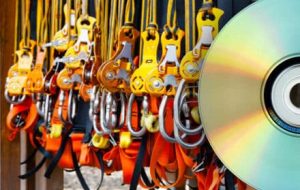Respiratory Protection
Home More Training Resources OSHA General Industry Training Requirements Respiratory Protection
OSHA Training Requirements - Emergency Action Plans
This website is not the official or final authority to determine OSHA compliance responsibilities, which are set forth in OSHA standards themselves, and the Occupational Safety and Health Act of 1970. Because OSHA regulations are constantly being added, deleted, and/or revised, you must not rely on this website as the official or final authority of OSHA training requirements; refer to the official OSHA regulations available on OSHA’s website (osha.gov). – See disclaimers.
1910.134 – Respiratory Protection
(c) – Respiratory protection program. This paragraph requires the employer to develop and implement a written respiratory protection program with required worksite-specific procedures and elements for required respirator use. The program must be administered by a suitably trained program administrator. In addition, certain program elements may be required for voluntary use to prevent potential hazards associated with the use of the respirator. The Small Entity Compliance Guide contains criteria for the selection of a program administrator and a sample program that meets the requirements of this paragraph. Copies of the Small Entity Compliance Guide will be available on or about April 8, 1998 from the Occupational Safety and Health Administration’s Office of Publications, Room N 3101, 200 Constitution Avenue, NW, Washington, DC, 20210 (202-219-4667).
(1) – In any workplace where respirators are necessary to protect the health of the employee or whenever respirators are required by the employer, the employer shall establish and implement a written respiratory protection program with worksite-specific procedures. The program shall be updated as necessary to reflect those changes in workplace conditions that affect respirator use. The employer shall include in the program the following provisions of this section, as applicable:
(vii) – Training of employees in the respiratory hazards to which they are potentially exposed during routine and emergency situations;
(viii) – Training of employees in the proper use of respirators, including putting on and removing them, any limitations on their use, and their maintenance;
(2) – Where respirator use is not required:
(i) – An employer may provide respirators at the request of employees or permit employees to use their own respirators, if the employer determines that such respirator use will not in itself create a hazard. If the employer determines that any voluntary respirator use is permissible, the employer shall provide the respirator users with the information contained in Appendix D to this section (“Information for Employees Using Respirators When Not Required Under the Standard”); and
(ii) – In addition, the employer must establish and implement those elements of a written respiratory protection program [Editor’s note: this includes training on care, use and storage] necessary to ensure that any employee using a respirator voluntarily is medically able to use that respirator, and that the respirator is cleaned, stored, and maintained so that its use does not present a health hazard to the user. Exception: Employers are not required to include in a written respiratory protection program those employees whose only use of respirators involves the voluntary use of filtering face-pieces (dust masks).
(3) – The employer shall designate a program administrator who is qualified by appropriate training or experience that is commensurate with the complexity of the program to administer or oversee the respiratory protection program and conduct the required evaluations of program effectiveness.
(4) – The employer shall provide respirators, training, and medical evaluations at no cost to the employee.
(g) – Use of respirators.
(3) – Procedures for IDLH atmospheres. For all IDLH atmospheres, the employer shall ensure that:
(iii) – The employee(s) located outside the IDLH atmosphere are trained and equipped to provide effective emergency rescue;
(h) – Maintenance and Care of Respirators
(4) – Repairs
(i) – Repairs or adjustments to respirators are to be made only by persons appropriately trained to perform such operations and shall use only the respirator manufacturer’s NIOSH-approved parts designed for the respirator;
(iii) – Reducing and admission valves, regulators, and alarms shall be adjusted or repaired only by the manufacturer or a technician trained by the manufacturer.
(i) – Breathing air quality and use. This paragraph requires the employer to provide employees using atmosphere-supplying respirators (supplied-air and SCBA) with breathing gases of high purity.
(5) – The employer shall ensure that compressors used to supply breathing air to respirators are constructed and situated so as to:
(iii) – Have suitable in-line air-purifying sorbent beds and filters to further ensure breathing air quality. Sorbent beds and filters shall be maintained and replaced or refurbished periodically following the manufacturer’s instructions.
(iv) – Have a tag containing the most recent change date and the signature of the person authorized by the employer to perform the change. The tag shall be maintained at the compressor.
(k) – Training and information. This paragraph requires the employer to provide effective training to employees who are required to use respirators. The training must be comprehensive, understandable, and recur annually, and more often if necessary. This paragraph also requires the employer to provide the basic information on respirators in Appendix D of this section to employees who wear respirators when not required by this section or by the employer to do so.
(1) – The employer shall ensure that each employee can demonstrate knowledge of at least the following:
(i) Why the respirator is necessary and how improper fit, usage, or maintenance can compromise the protective effect of the respirator;
(ii) What the limitations and capabilities of the respirator are;
(iii) How to use the respirator effectively in emergency situations, including situations in which the respirator malfunctions;
(iv) How to inspect, put on and remove, use, and check the seals of the respirator;
(v) What the procedures are for maintenance and storage of the respirator;
(vi) How to recognize medical signs and symptoms that may limit or prevent the effective use of respirators; and
(vii) The general requirements of this section.
(2) – The training shall be conducted in a manner that is understandable to the employee.
(3) – The employer shall provide the training prior to requiring the employee to use a respirator in the workplace.
(4) – An employer who is able to demonstrate that a new employee has received training within the last 12 months that addresses the elements specified in paragraph (k)(1)(i) through (vii) is not required to repeat such training provided that, as required by paragraph (k)(1), the employee can demonstrate knowledge of those element(s). Previous training not repeated initially by the employer must be provided no later than 12 months from the date of the previous training.
(5) – Retraining shall be administered annually, and when the following situations occur:
(i) Changes in the workplace or the type of respirator render previous training obsolete;
(ii) Inadequacies in the employee’s knowledge or use of the respirator indicate that the employee has not retained the requisite understanding or skill; or
(iii) Any other situation arises in which retraining appears necessary to ensure safe respirator use.
(6) – The basic advisory information on respirators, as presented in Appendix D of this section, shall be provided by the employer in any written or oral format, to employees who wear respirators when such use is not required by this section or by the employer.
Appendix D to Sec. 1910.134 (Mandatory) Information for Employees Using Respirators When Not Required Under the Standard
Respirators are an effective method of protection against designated hazards when properly selected and worn. Respirator use is encouraged, even when exposures are below the exposure limit, to provide an additional level of comfort and protection for workers. However, if a respirator is used improperly or not kept clean, the respirator itself can become a hazard to the worker. Sometimes, workers may wear respirators to avoid exposures to hazards, even if the amount of hazardous substance does not exceed the limits set by OSHA standards. If your employer provides respirators for your voluntary use, or if you provide your own respirator, you need to take certain precautions to be sure that the respirator itself does not present a hazard.
You should do the following:
1. Read and heed all instructions provided by the manufacturer on use, maintenance, cleaning and care, and warnings regarding the respirators limitations.
2. Choose respirators certified for use to protect against the contaminant of concern. NIOSH, the National Institute for Occupational Safety and Health of the U.S. Department of Health and Human Services, certifies respirators. A label or statement of certification should appear on the respirator or respirator packaging. It will tell you what the respirator is designed for and how much it will protect you.
3. Do not wear your respirator into atmospheres containing contaminants for which your respirator is not designed to protect against. For example, a respirator designed to filter dust particles will not protect you against gases, vapors, or very small solid particles of fumes or smoke.
4. Keep track of your respirator so that you do not mistakenly use someone else’s respirator.

On Site OSHA Training Classes

Online OSHA Training Courses

